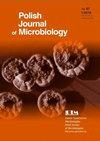Graves病和桥本甲状腺炎患者肠道菌群的变化及其机制
IF 1.6
4区 生物学
Q4 MICROBIOLOGY
引用次数: 7
摘要
探讨肠道菌群在Graves病(GD)和桥本甲状腺炎(HT)中的作用。收集了70份粪便样本,其中GD患者27例,HT患者27例,健康志愿者16例。化学发光法检测甲状腺功能及自身抗体(FT3、FT4、TSH、TRAb、TGAb、TPOAb);采用甲状腺超声和16S测序对粪便样品进行细菌分析;利用京都基因与基因组百科全书(KEGG)和COG (Clusters of Orthologous Groups)对其功能预测和发病机制进行分析。GD组和HT组的肠道菌群总体结构与健康对照组有显著差异。变形菌群和放线菌群含量以HT组最高。与对照组相比,GD和HT组丹毒毛菌、蓝藻菌和瘤胃球菌的丰度较高,杆菌科和巨单胞菌的丰度较低。进一步分析KEGG发现,“ABC转运体”代谢途径与GD和HT的发生高度相关。COG分析显示,与健康对照组相比,GD和HT组碳水化合物运输和代谢富集,但氨基酸运输和代谢不富集。我们的数据提示芽孢杆菌、Blautia和ornithinimicroum可以作为区分GD和HT与健康人群的潜在标志物,“ABC转运体”代谢途径可能参与了GD和HT的发病机制。本文章由计算机程序翻译,如有差异,请以英文原文为准。
Alterations and Mechanism of Gut Microbiota in Graves’ Disease and Hashimoto’s Thyroiditis
Abstract To explore the role of gut microbiota in Graves’ disease (GD) and Hashimoto’s thyroiditis (HT). Seventy fecal samples were collected, including 27 patients with GD, 27 with HT, and 16 samples from healthy volunteers. Chemiluminescence was used to detect thyroid function and autoantibodies (FT3, FT4, TSH, TRAb, TGAb, and TPOAb); thyroid ultrasound and 16S sequencing were used to analyze the bacteria in fecal samples; KEGG (Kyoto Encyclopedia of Genes and Genomes) and COG (Clusters of Orthologous Groups) were used to analyze the functional prediction and pathogenesis. The overall structure of gut microbiota in the GD and HT groups was significantly different from the healthy control group. Proteobacteria and Actinobacteria contents were the highest in the HT group. Compared to the control group, the GD and HT groups had a higher abundance of Erysipelotrichia, Cyanobacteria, and Ruminococcus_2 and lower levels of Bacillaceae and Megamonas. Further analysis of KEGG found that the “ABC transporter” metabolic pathway was highly correlated with the occurrence of GD and HT. COG analysis showed that the GD and HT groups were enriched in carbohydrate transport and metabolism compared to the healthy control group but not in amino acid transport and metabolism. Our data suggested that Bacillus, Blautia, and Ornithinimicrobium could be used as potential markers to distinguish GD and HT from the healthy population and that “ABC transporter” metabolic pathway may be involved in the pathogenesis of GD and HT.
求助全文
通过发布文献求助,成功后即可免费获取论文全文。
去求助
来源期刊

Polish Journal of Microbiology
MICROBIOLOGY-
CiteScore
3.70
自引率
4.80%
发文量
41
审稿时长
2 months
期刊介绍:
Polish Journal of Microbiology (PJM) publishes original research articles describing various aspects of basic and applied microbiological research. We are especially interested in articles regarding
- basic biological properties of bacteria and archaea, viruses, and simple
- eukaryotic microorganisms
- genetics and molecular biology
- microbial ecology
- medical bacteriology and public health
- food microbiology
- industrial microbiology
- bacterial biotechnology
 求助内容:
求助内容: 应助结果提醒方式:
应助结果提醒方式:


